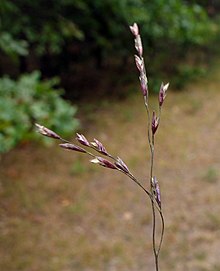Poa
| Poa | |
|---|---|

| |
| Poa annua (Annual Meadow-grass) | |
| Scientific classification | |
| Kingdom: | |
| (unranked): | |
| (unranked): | |
| (unranked): | |
| Order: | |
| Family: | |
| Genus: | Poa |
| Species | |
|
About 500 species, including: | |


Poa is a genus of about 500 species of grasses, native to the temperate regions of both hemispheres. Common names include meadow-grass (mainly Europe and Asia), bluegrass (mainly North America), tussock (some New Zealand species), and speargrass. 'Poa' is greek for fodder.
Bluegrass, which has green leaves, derives its name from the seed heads which are blue when the plant is allowed to grow to its natural height of two to three feet.[1]
One species, Smooth Meadow-grass Poa pratensis, is the type species of the family Poaceae.
The genus Poa includes both annual and perennial species. Most are monoecious, but a few are dioecious (separate male and female plants). The leaves are narrow, folded or flat, sometimes bristled, and with the basal sheath flattened or sometimes thickened, with a blunt or hooded apex and membranaceous ligule.
Cultivation and uses
Many of the species are important pasture plants, used extensively by grazing livestock. Kentucky bluegrass (Poa pratensis) is the most extensively used cool-season grass used in lawns, sports fields, and golf courses in the United States.[2] Annual bluegrass (Poa annua) can sometimes be considered a weed.[3]
Since the 1950s/early 1960s 90 percent of the seed has been produced on farms in Idaho, Oregon and Washington.[4]
Some of the Poa species are popular for gardens and for landscaping in New Zealand.
Insect foodplant
Lepidoptera whose caterpillars feed on Poa include:
- Common Wood-Nymph, Cercyonis pegala
- Hobomok Skipper, Poanes hobomok
- Zabulon Skipper, Poanes zabulon
References
- Kew gardens grass database
- The Observers Book of Grasses, Sedges and Rushes. Frances Rose. pages 38–39,42-47
- ^ What Makes Kentucky's Bluegrass Blue - New York Times - June 3, 1993
- ^ Dvorchak, Robert (June 13, 2007). "Oakmont-inspired Stimpmeter allows USGA to accurately measure speed, consistency of putting surfaces". Pittsburgh Post-Gazette. Retrieved 2007-09-08.
- ^ Ohlendorf, B. (April, 2003). "Annual Bluegrass Management Guidelines--UC IPM". University of California. Retrieved 2007-09-08.
{{cite web}}: Check date values in:|date=(help); Unknown parameter|coauthors=ignored (|author=suggested) (help) - ^ Western Kansas Agricultural Resource Centers Bluegrass Production Report
